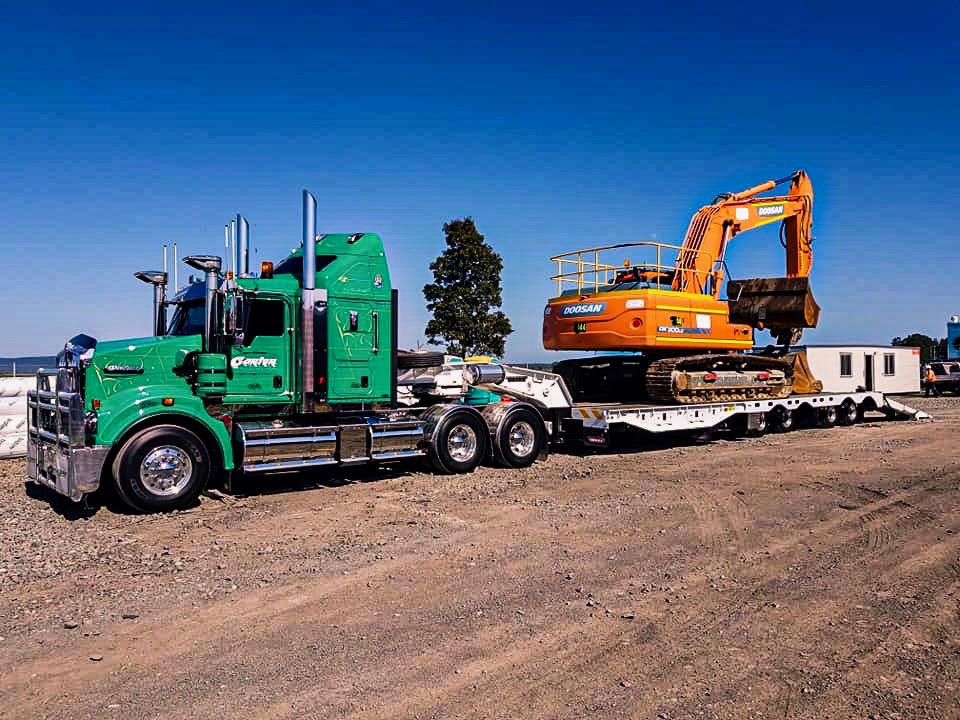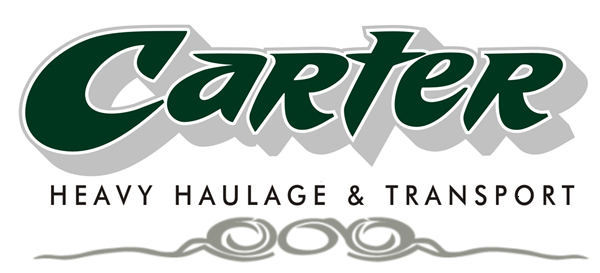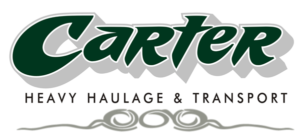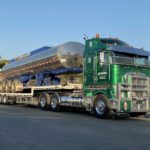
Loading and unloading equipment should only be done by people with the relevant knowledge and experience. Heavy loads can be extremely dangerous if not handled correctly. At Carter Heavy Haulage, we believe the safety of our team, and your equipment is paramount, so we take loading procedures very seriously.
Loading and unloading equipment: our approach
To ensure equipment is loaded and unloaded safely, our team members must have the appropriate training and experience. This includes being inducted into our internal policies, procedures, and processes.
These internal guidelines are also used in conjunction with site specific rules and traffic management plans, site induction training and regulations relevant to each individual equipment and vehicle specifications.
Our vehicles are fitted with in-fleet telematic systems which assist our drivers to ensure that loads are correctly positioned, and drivers record mass and dimension data for each load.
Each vehicle also has a copy of the National Transport Commission’s Load Restraint Guide 2018 which provides a ready reference for our drivers should they come across something out of the ordinary
The National Heavy Vehicle Regulator has set loading/unloading regulations and also publishes accessible reference material specific to loading, unloading and transport movements.
Risk assessments
Before loading and unloading equipment, a thorough risk assessment should be carried out which considers every step of the job, including site risks and hazards, loading, transport, and unloading. This is particularly necessary in the case of an unfamiliar commodity or location and/or where there are unfavourable weather conditions.
Communication with site personnel is necessary to ensure the safety of drivers, workers on the site and the general public. If a specific risk or hazard that cannot be eliminated is identified, operations should not take place until control measures have been determined and implemented.
Safe loading/unloading areas
Before any load or unload commences, we require all drivers to complete a situational risk assessment and implement the necessary controls.
Designated loading/unloading areas should be sectioned off where required, a check should be done for overhead electric cables, the area should be cleared of debris, and any uneven surfaces should be identified.
Pedestrians and workers not involved in the loading/unloading process should vacate the area, there should be no chance of vehicles coming into contact with stray cables or wires and trailers must be parked on firm level ground so the load can be positioned evenly.
A safe waiting place should also be available to all persons on a site that are not involved in the loading / unloading until the operation is completed and loads are appropriately restrained.
Load restraint/security
The golden rule here is: an uneven or overloaded vehicle is a dangerous one. Uneven loads cause the vehicle to lose balance, so all weight should be distributed as evenly as possible across the trailer throughout the loading and unloading process.
If this is not considered, it causes great risk on the road, with overloaded vehicles potentially becoming unstable, making steering difficult and increasing strain on the vehicle when braking.
All equipment should be loaded, positioned and secured in a safe and logical manner that eliminates the risk of movement and in a way that considers the unloading process – to ensure no unnecessary risk at the end of the journey.
Load restraints should be checked periodically to ensure that there has not been any movement of the load during the journey and that there has not been any wear on the restraints themselves and that they are still safe.
Safety equipment and risk prevention measures
We have a range of job-specific equipment and processes in place to ensure loading and unloading of equipment is done safely,
– vehicles are fitted with warning lights and signals and appropriate signage whether it be over size signs or dangerous goods signage,
– high visibility cones are available to cordon off the work zone as necessary,
– qualified forklift operators or crane operators are used when required,
– a harness system is used when working at height, and
– PPE is used at all times.
The loading/unloading area should also feature safeguards to prevent the driver inadvertently moving the vehicle before the load is fully secured.
To reduce this risk, we utilise:
– traffic lights to clearly indicate when safe to move,
– vehicle and trailer restraints to prevent movement, and
– process whereby the vehicle keys and/or paperwork is handed over to the person in charge of loading/unloading, and only given back to the driver when safe to move.
Communication
We can utilise all the equipment in the world, but the most effective and important safety tool is communication.
Challenges to communication, such as language barriers are addressed through clear signage which uses nationally recognised symbols.
Communication is especially important when multiple companies are involved in a load, each bringing their own varying job processes and approaches to safety.
To combat this, we take the time to plan every job in advance, with an agreement reached regarding how the load will be handled, who will be there to oversee the job, how they will be instructed, and what equipment is needed. All parties are across each step of the process to ensure we’re all on the same page.
Vehicle readiness
The readiness of the vehicle has a big impact when loading and unloading equipment. All trucks must be fully maintained to manufacturer’s specifications and safety standards, with the relevant registration.
The vehicle must also have the capability and features required to handle the load. Vehicle operators must also utilise available safety features relevant to the job, e.g. vehicle/trailer brakes and stabilisers applied while loading/unloading.
The vehicle’s tailgates and sideboards must be closed if they can. Over-hang should be avoided where possible and kept to a minimum if unavoidable. The vehicle must be clearly marked if and where a load has over-hang.
Load packaging
Before loading/unloading equipment, team members must ensure the load is suitably packaged. For example, if pallets are being used, they need to be in good condition, properly secured to the load and the pallet itself must be suitable for the equipment being transported.
On reaching the destination, a check should be made on the packaging and restraints prior to unloading. This is to ensure goods haven’t shifted or restraints failed during transit. This mitigates the risk of loads moving or falling when the packaging/restraints are removed in the unloading stage.
Some loads can be difficult to secure during transport. So, hauliers and recipients must exchange information about any job and equipment-specific details and requirements prior to loading and unloading.
Timing
Safety takes priority over speed when loading and unloading equipment. Time will vary depending on the location, load, vehicle, and machinery.
For example, smaller machines usually take 30-45 minutes to complete a load/unload. The larger machines (or machines with multiple attachments) could take more than an hour.
We believe it is our responsibility to take care of the equipment/product we transport from start to finish. Our team ensure nothing is damaged and all equipment used meets mandatory load restraint guidelines.
A client may choose to be onsite to supervise or oversee the loading/unloading. However it is not their responsibility to ensure the operation is done safely. That lies with our team, who have the experience and knowledge to ensure the process is as safe and efficient as possible.
Our loading/unloading procedures ensure our team, and your equipment are kept safe.



